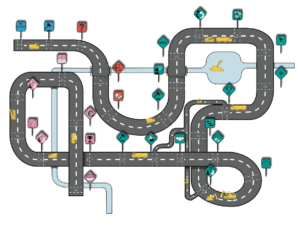The growth of urban populations will generate a need to further develop cities, which will lead to a significant increase in construction work in cities. Because of the change from building in greenfield areas to brownfield areas, more people will experience the accompanying nuisances the increase of construction work brings.
The accompanied nuisances relate to emissions and the reductions of the liveability, safety and accessibility of cities during the execution of construction projects. To ensure the reduction of nuisances caused by construction tasks are reduced, a number of smart solutions in construction logistics have been developed. These solutions relate to the actions municipalities, contractors, wholesalers, and several other stakeholders can take. The smart solutions, among other things, provide concepts related to reductions of the amount of traffic.
Eke Hoekstra from Technical University Delft wrote her thesis about how the Amsterdam government can stimulate smart solutions for construction logistics.
Local government
It is in the local government’s interest that feasible, effective and efficient solutions in construction logistics are further developed and applied on a larger scale, as this will help them to achieve their stated sustainable ambitions and increase the liveability and accessibility of urban confined areas during the construction phase of projects.
However, on an operational level, municipalities do not sufficiently know how to stimulate the implementation of smart solutions in construction logistics in order to minimise nuisances caused by the construction sector. In order to respond to this shortcoming, the objective of this thesis is to provide a supporting tool to enable municipalities to stimulate market stakeholders to implement smart solutions in construction logistics in their projects.
Multi actor – multi criteria
Because of the many different roles municipalities can play (client, licensor, coordinator, and owner of ground), the various types of projects municipalities conduct and the diversity in contract types is the Design Statement more specified than the objective of this thesis. The Design Statement can be read as follows: ‘Developing a tool that will give support to employees of municipalities working on the realisation of UAV-GC (Uniforme Administratieve Voorwaarden – Geïntegreerde Contractvormen) procured civil works, helping them to stimulate market stakeholders to implement smart solutions in construction logistics into projects.’
In order to respond to the Design Statement, a design of a supporting tool is developed. Prior to this, a number of Design Requirements that the design must satisfy are articulated. This requires, among other things, conducting research focusing on three aspects, being firstly, municipalities their deployable instruments to stimulate smart solutions in construction logistics, secondly, the process steps in municipalities its procured UAV-GC civil works projects and thirdly, the specifications of the deployable instruments.
Research
By researching seven different subjects the deployable instruments were found:
- a literature study on smart solutions in construction logistics
- the smart solutions in construction logistics that are implementable by market stakeholders or by municipalities
- the influence that municipalities have on the implementation of smart solution that can be implemented by market stakeholders
- the level of applicability of smart solutions when implemented in civil projects
- the specific related market stakeholders, obstacles
- incentives that market stakeholders face and actions that municipalities can take.
Instruments
The instruments for stimulating smart construction logistics solutions are: Procurement, Communication, Material agency, Contract management, BLVC, and Coordination department. The second research focus has resulted in a flow chart of the UAV-GC process that is divided in four phases and contains 23 process steps. From the third research focus, a list of contributors and obstructers that occur per instrument relating to the stimulation of smart solutions in construction logistics was developed.
In addition to the design requirements that relate to the three research aspects, also other design requirements are formulated. They are derived from the scope, objective, and interview sessions with future users. The requirements are used as a starting point in the design phase of the tool for which different iterative design steps are taken.
Project roadmap
The final version of the tool represents a Project Roadmap It is presented as a small booklet printed in A5 size. The booklet is primarily made out of two parts, being a graphic and an explanation text. The icons displayed on the traffic signs represent the actions that take place during each intersection. The traffic signs are shaped in two different forms, being a diamond and square, representing respectively actions that can be taken in order to reduce construction related nuisances and actions that only consist of process step explanations.
The Project Roadmap responds to the stated Design Statement and ensures that all Dutch municipalities obtain guidance on how to stimulate market stakeholders to implement smart solutions in construction logistics in UAV-GC procured civil structure projects. It is recommended to keep supplementing the Project Roadmap with the latest information concerning municipalities its deployable instruments and smart solution in construction logistics in urban confined areas.
You can find the full report by clicking here.

